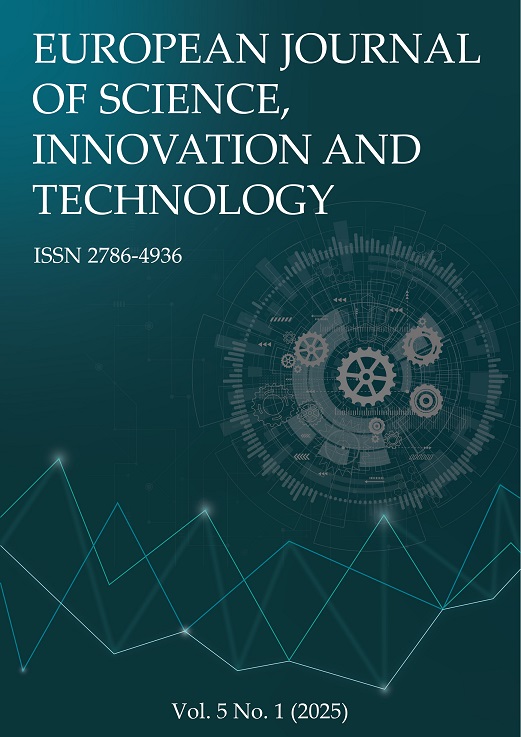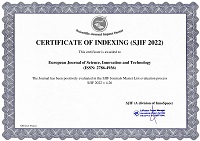Long Term Electricity Demand Forecasting in Nigeria
Abstract
This study focuses on forecasting long-term electricity demand in Nigeria using three distinct methods: Nonlinear Autoregressive with Exogenous Input Neural Network (NARX), Support Vector Regression (SVR), and Exponential Smoothing - Holt Winters (ES-HW). Over eight years of data from the National Control Centre were utilized to develop and compare these models. The ES-HW model, despite its reliance on limited input data, demonstrated ability to replicate the seasonal patterns and trends in electricity demand, even though it resulted in a higher relative root mean square error (RRMSE) than the other method. While SVR showed slightly better performance metrics, ES-HW provided a more accurate depiction of demand fluctuations over time. The study identified key insights, such as the critical impact of data availability on forecasting accuracy and the comparative effectiveness of different modeling approaches. The research highlights the challenges posed by limited historical data in the Nigerian electricity sector, which constrained the accuracy and scope of the forecasts. Overall, this work contributes valuable knowledge to energy modeling and policy-making, offering a foundation for sustainable energy planning in Nigeria.
References
Abdulsalam, K. A., & Babatunde, O. M. (2019). Electrical energy demand forecasting model using artificial neural network: A case study of Lagos State Nigeria. International Journal of Data and Network Science, 3, 305-322.
Akay, D., & Atak, M. (2007). Grey prediction with rolling mechanism for electricity demand forecasting of Turkey. Energy, 32(9), 1670-1675.
Al-Farttoosi, S. A., & Mansouri, B. (2019). Predicting Electricity consumption of Misan Province of Iraq Using Univariate Time Series Analysis. Opción, 89, 2899-2921.
Almeshaiei, E., & Soltan, H. (2011). A methodology for electric power load forecasting. Alexandria Engineering Journal, 50(2), 137-144.
Andoh, P. Y. A., Sekyere, C. K. K., Mensah, L. D., & Dzebre, D. E. K. (2021). Forecasting electricity demand in Ghana with the SARIMA model. Journal of Applied Engineering and Technological Science, 3(1), 1-9.
Aprillia, H., Yang, H. T., & Huang, C. M. (2019). Optimal decomposition and reconstruction of discrete wavelet transformation for short-term load forecasting. Energies, 12(24), 4654.
Atanane, A., Benabbou, L., & El Ouafi, A. (2023, November). Electricity demand forecasting: a systematic literature review. In 2023 14th International Conference on Intelligent Systems: Theories and Applications (SITA) (pp. 1-8). IEEE.
Bedi, J., & Toshniwal, D. (2019). Deep learning framework to forecast electricity demand. Applied energy, 238, 1312-1326.
Bindiu, R., Chindris, M., & Pop, G. V. (2009). Day-ahead load forecasting using exponential smoothing. Scientific Bulletin of the Petru Maior University of Tirgu Mures, 6, 89-93.
Chen, B. J., Chang, M. W., & Lin, C.J. (2004). Load forecasting using support vector machines: a study on EUNITE Competition. IEEE Transactions on Power Systems, 19(4), 1821-1830.
Contreras-Salinas, J., López, F., Rondon-Rodriguez, C. A., et al. (2020). Analysis of energy consumption in Colombia using the Holt method. International Journal of Energy Economics and Policy, 10(6), 679-683.
Dedinec, A. (2016). Correlation of variables with electricity consumption data. In International Conference on information society and technology ICIST 2016 (pp. 118-123).
Dharma, A., Robandi, I., & Purnomo, M. H. (2011). Application of interval type-2 fuzzy logic system in short term load forecasting on special days. IPTEK The Journal for Technology and Science, 22(2), 110-115.
Dudek, G. (2015). Short-term load forecasting using random forests. Intelligent systems, 323, 821-828.
Ebakumo, O. (2021). Electrical energy demand forecast in Nigeria between 2020-2040 using probabilistic extrapolation method. International Journal of Engineering Science and Application, 5(3), 71-85.
Emmanuel, O. O., Adebanji, A., & Labeodan, O. (2014). Using Holt Winter’s Multiplicative Model to Forecast Assisted Childbirths at the Teaching Hospital in Ashanti Region, Ghana. Journal of Biology, Agriculture and Healthcare, 4(9), 83-89.
Erdogdu, E. (2007). Electricity demand analysis using cointegration and ARIMA modelling: A case study of Turkey. Energy Policy, 35(2), 1129-1146.
Ezennaya, O. S., Isaac, O. E., Okolie, U. O., & Ezeanyim, O. I. C. (2014). Analysis of Nigeria’s national electricity demand forecast (2013–2030). International Journal of Science and Technology Research, 3(3), 333-340.
Ezenugu, I. A., Nwokonko, S. C., & Markson, I. (2017). Modelling and Forecasting of residential electricity consumption in Nigeria using Multiple and Quadratic regression models. American Journal of Software Engineering and Applications, 6(3), 99-104.
Farber, R. (2011). CUDA application design and development. Elsevier.
Hernández, L., Baladrón, C., Aguiar, J. M., Carro, B., Sánchez-Esguevillas, A., & Lloret, J. (2014). Artificial neural networks for short-term load forecasting in microgrids environment. Energy, 75, 252-264.
Hsu, C. W. & Lin, C. J. (2002). A comparison of Methods of Multiclass Support vector machines. IEEE Transactions on Neural Networks, 13(2), 415-425.
Idoniboyeobu, D. C., Ogunsakin, A. J., & Wokoma, B. A. (2018). Forecasting of electrical energy demand in Nigeria using modified form of exponential model. American Journal of Engineering Research, 7(1), 122-135.
Mati, A. A., Gajoga, B. G., Jimoh, B., Adegobye, A., & Dajab, D. D. (2009). Electricity demand forecasting in Nigeria using time series model. The Pacific Journal of Science and Technology, 10(2), 479-485.
Mir, A. A., Alghassab, M., Ullah, K., Khan, Z. A., Lu, Y., & Imran, M. (2020). A review of electricity demand forecasting in low and middle income countries: The demand determinants and horizons. Sustainability, 12(15), 5931-5941.
Mirasgedis, S., Sarafidis, Y., Georgopoulou, E., Lalas, D. P., Moschovits, M., Karagiannis, F., & Papakonstantinou, D. (2006). Models for mid-term electricity demand forecasting incorporating weather influences. Energy, 31(2-3), 208-227.
Montgomery, D. C., Jennings, C. L., & Kulahci, M. (2015). Introduction to time series analysis and forecasting. John Wiley & Sons.
Nafil, A., Bouzi, M., Anoune, K., & Ettalabi, N. (2020). Comparative study of forecasting methods for energy demand in Morocco. Energy Reports, 6, 523-536.
Nigeria Climate. (2024). Climate Zone and Historical Climate Data. Retrieved from Weather and Climate: https://weatherandclimate.com/nigeria
Nti, I.K., Teimeh, M., Nyarko-Boateng, O., & Adebayo, F. A. (2020). Electricity load forecasting: a systematic review. Journal of Electrical Systems and Inf Technol, 7(13).
Okakwu, I. K., Oluwasogo, E. S., Ibhaze, A. E., & Imoize, A. L. (2019). A comparative study of time series analysis for forecasting energy demand in Nigeria. Nigerian Journal of Technology, 38(2), 465-469.
Ozveren C. S. & King, D. J. (2007). Short term load forecasting using Multiple Linear Regression. Proceedings of the universities power engineering conference, 42, 1-10. University of Abertay Dundee, UK.
Rodriguez-Perez, R., & Bajorath, J. (2022). Evolution of support vector machine and regression modelling in chemoinformatics and drug discovery. Journal of Computer-Aided Molecular Design, 36(5), 355-362.
Saravanan, S., Kannan, S., & Thangaraj, C. (2012). India’s electricity demand forecast using regression analysis and artificial neural networks based on principal components. ICTACT Journal on soft computing, 2(4), 365-370.
Şişman, B. (2017). A comparison of ARIMA and grey models for electricity consumption demand forecasting: The case of Turkey. Kastamonu Üniversitesi İktisadi ve İdari Bilimler Fakültesi Dergisi, 13(3), 234-245.
Stern, D. I. (2004). Economic growth and energy. Encyclopedia of energy, 2, 35-51.
Sum, J. P. F., Kan, W. K., & Young, G. H. (1999). A note on the equivalence of NARX and RNN. Neural Computing & Applications, 8, 33-39.
Taylor, J. W., & Buizza, R. (2003). Using weather ensemble predictions in electricity demand forecasting. International Journal of forecasting, 19(1), 57-70.
Vasquez, A. R. G., Rodriguez, M. E. F., & Dayupay, R. C. (2020). Energy Consumption Forecasting Model for Puerto Princesa Distribution System Using Multiple Linear Regression. International Journal of Innovative Science and Research, 5(11), 37-40.
Yukseltan, E., Yucekaya, A., & Bilge, A. H. (2017). Forecasting electricity demand for Turkey: Modeling periodic variations and demand segregation. Applied Energy, 193, 287-296.
Copyright (c) 2025 E. Efekemo, E. G. Saturday, J. C. Ofodu

This work is licensed under a Creative Commons Attribution 4.0 International License.


 ISSN
ISSN 











